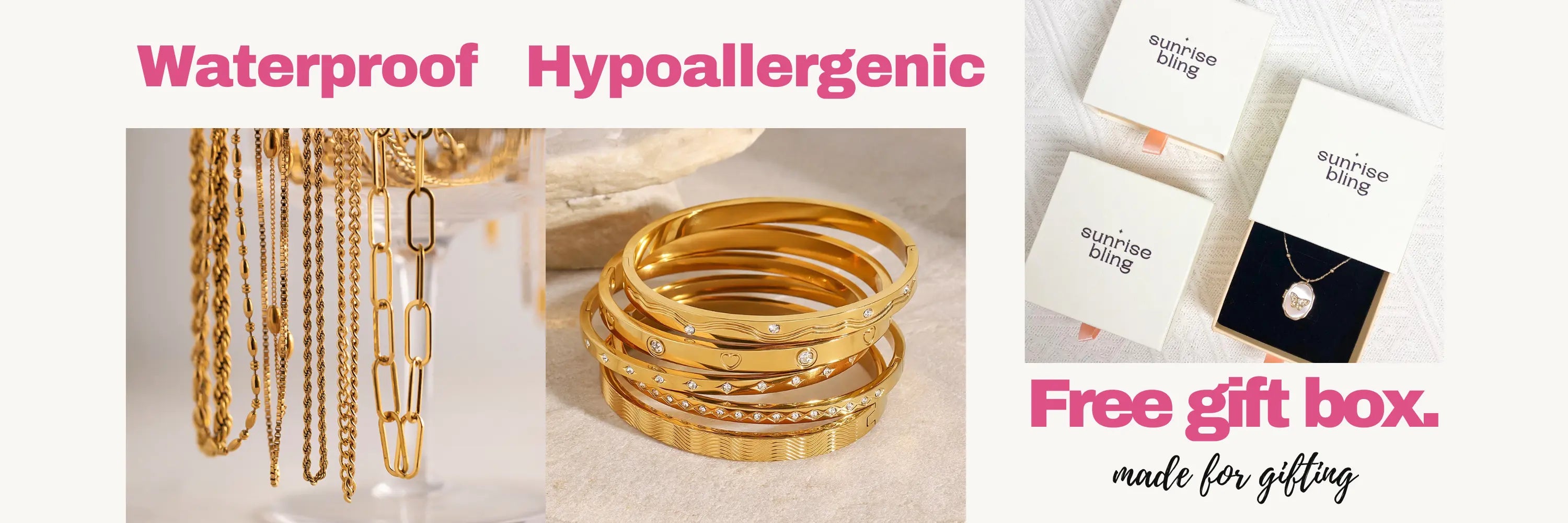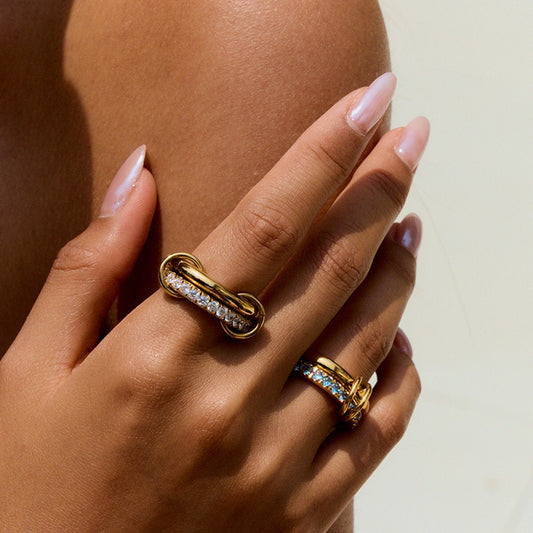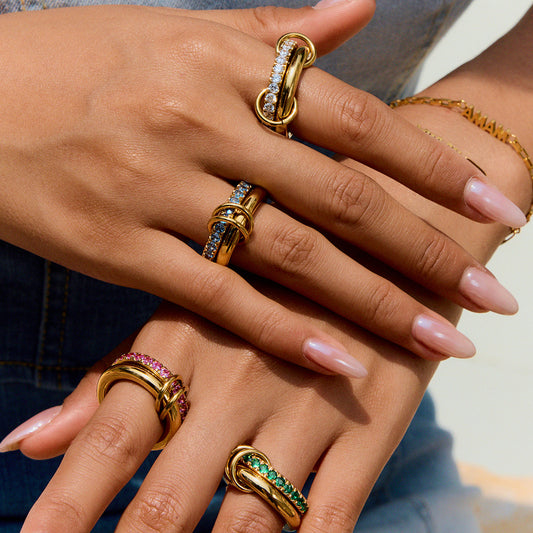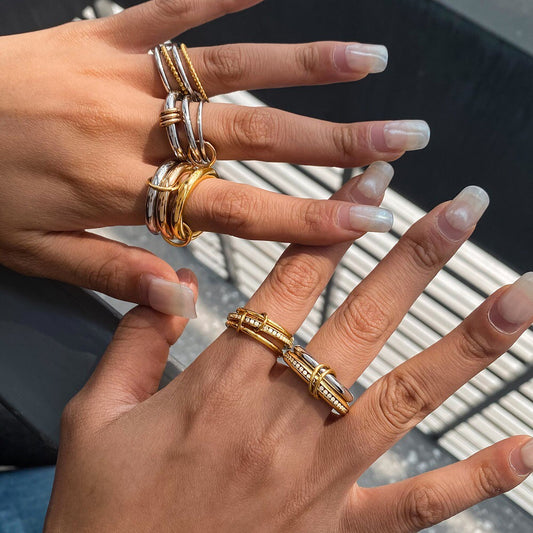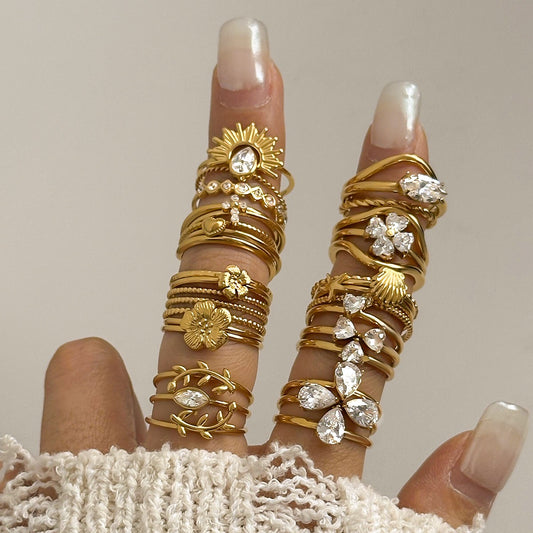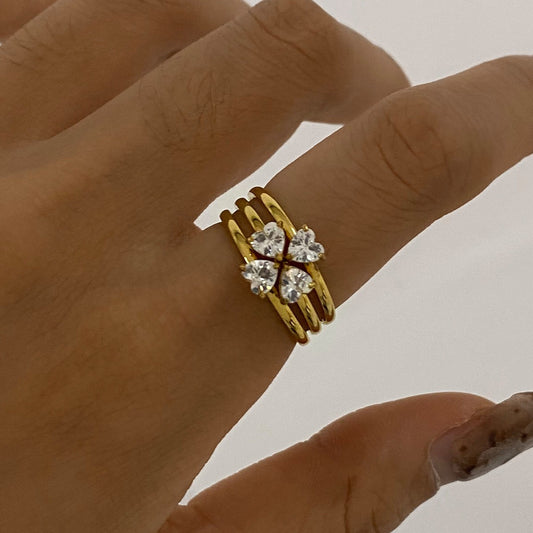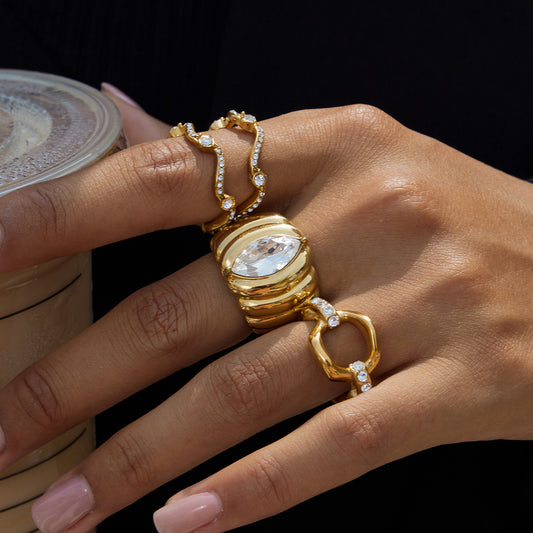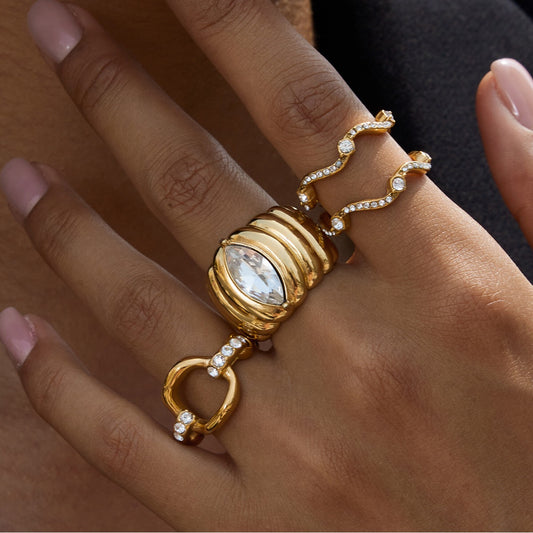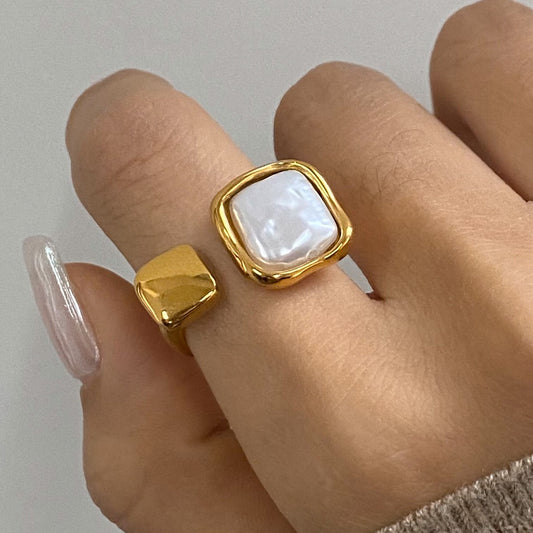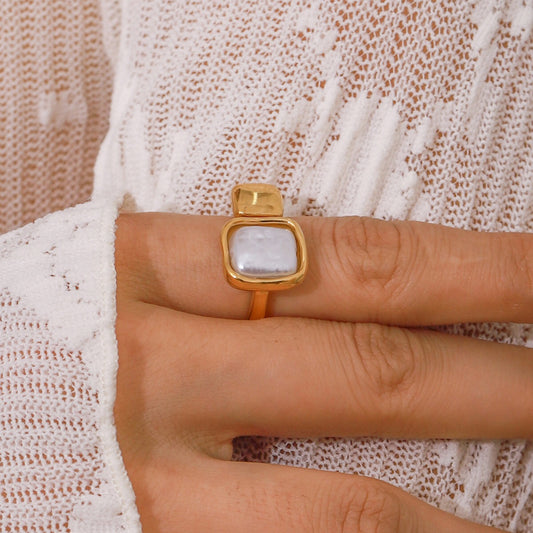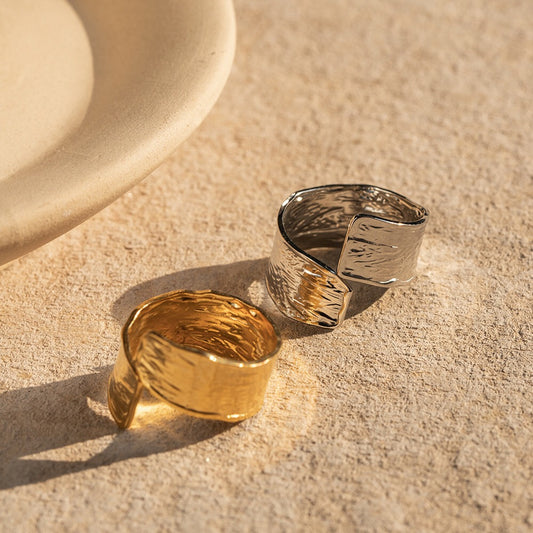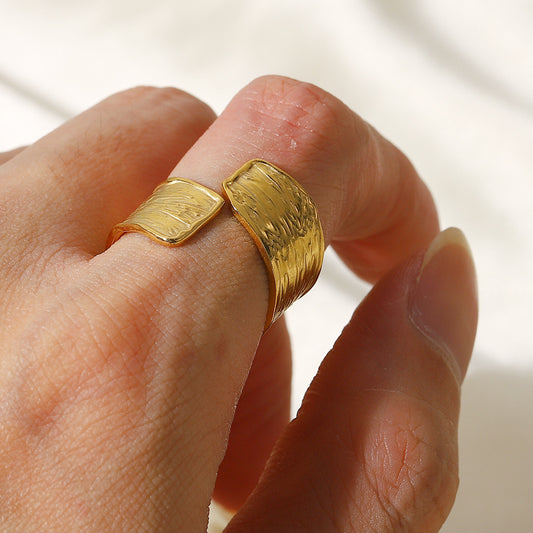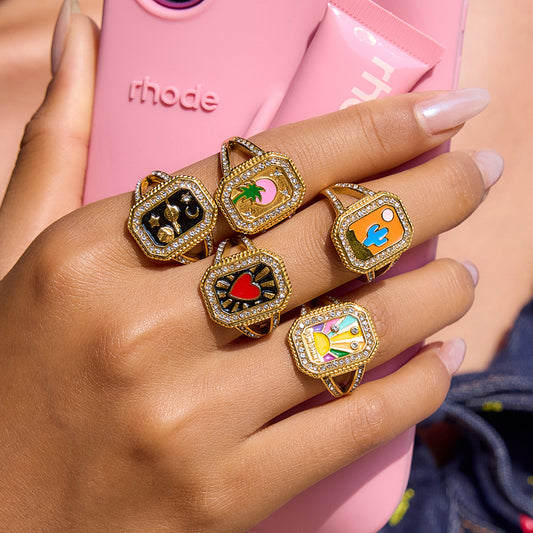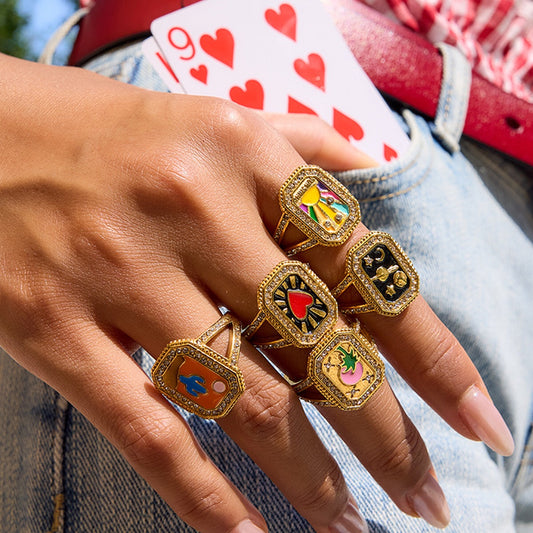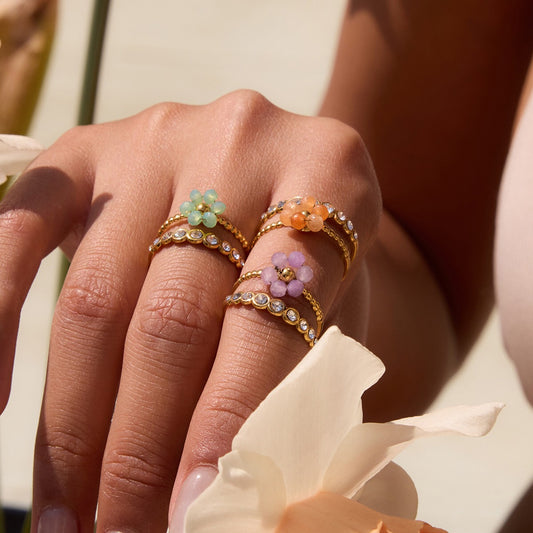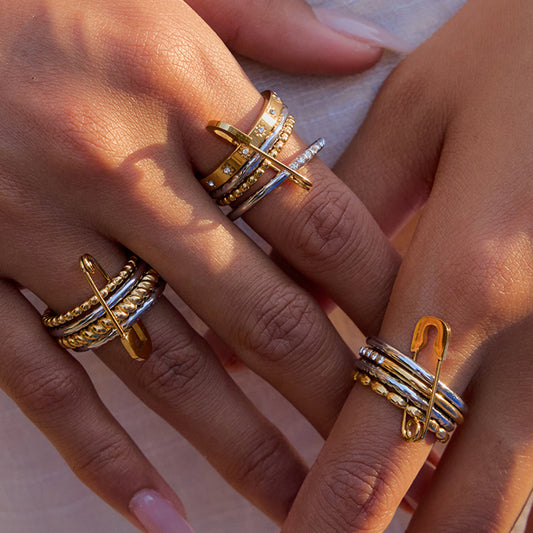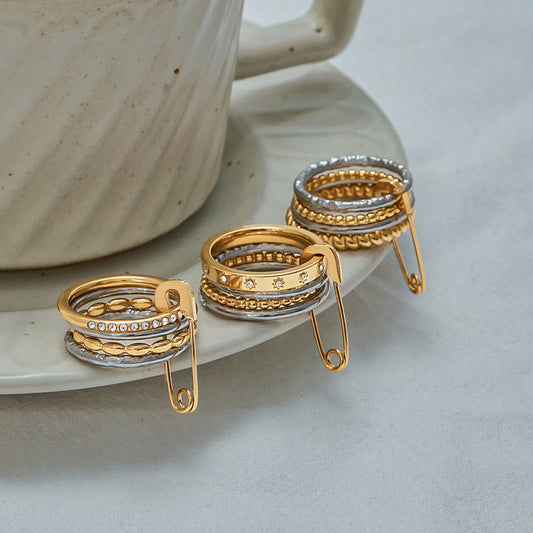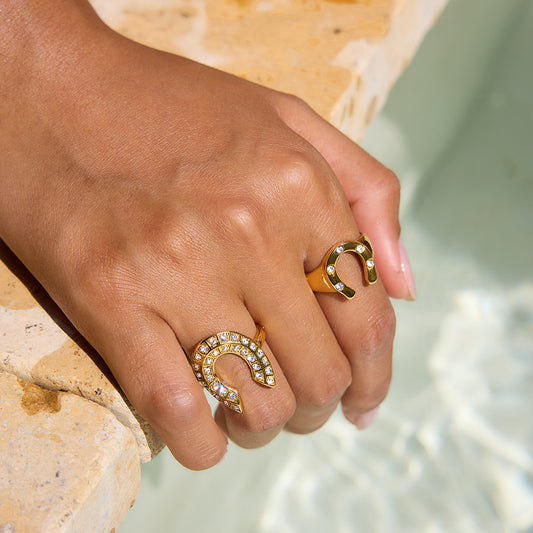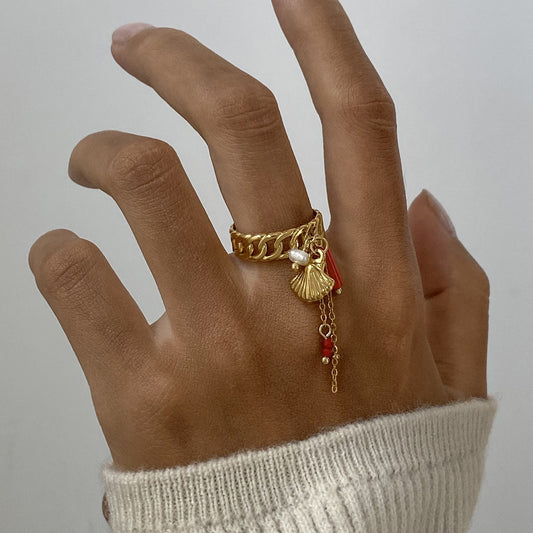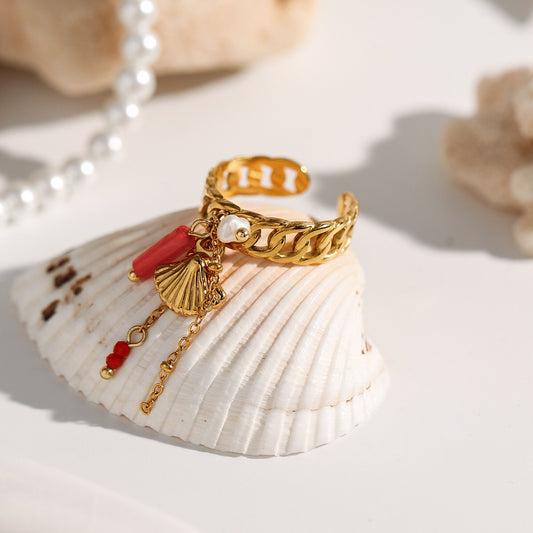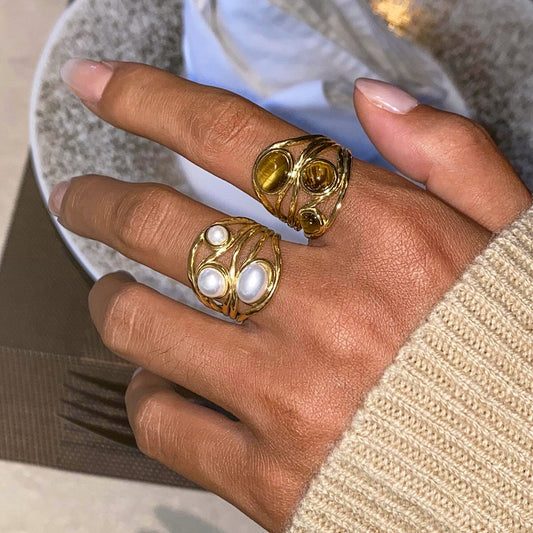White Gold Ring has long been a staple of elegant jewelry, blending the warmth of gold with a modern, silvery finish that complements every skin tone and style. The global jewelry market size was estimated at USD 366.79 billion in 2024 and is projected to reach USD 578.45 billion by 2033, growing at a CAGR of 5.3%. What makes them so beloved? Unlike yellow gold (which can feel traditional) or platinum (which comes with a steep price tag), white gold strikes the perfect balance: it’s versatile enough for everyday wear, sophisticated enough for formal events, and affordable enough for most budgets. Whether you’re looking for an engagement ring, a stackable band, or a sentimental gift for your wife, a white gold ring offers sleek glamour that never goes out of style. This guide covers everything you need to know about white gold rings, from their composition to why they’re the ideal gift for your spouse.
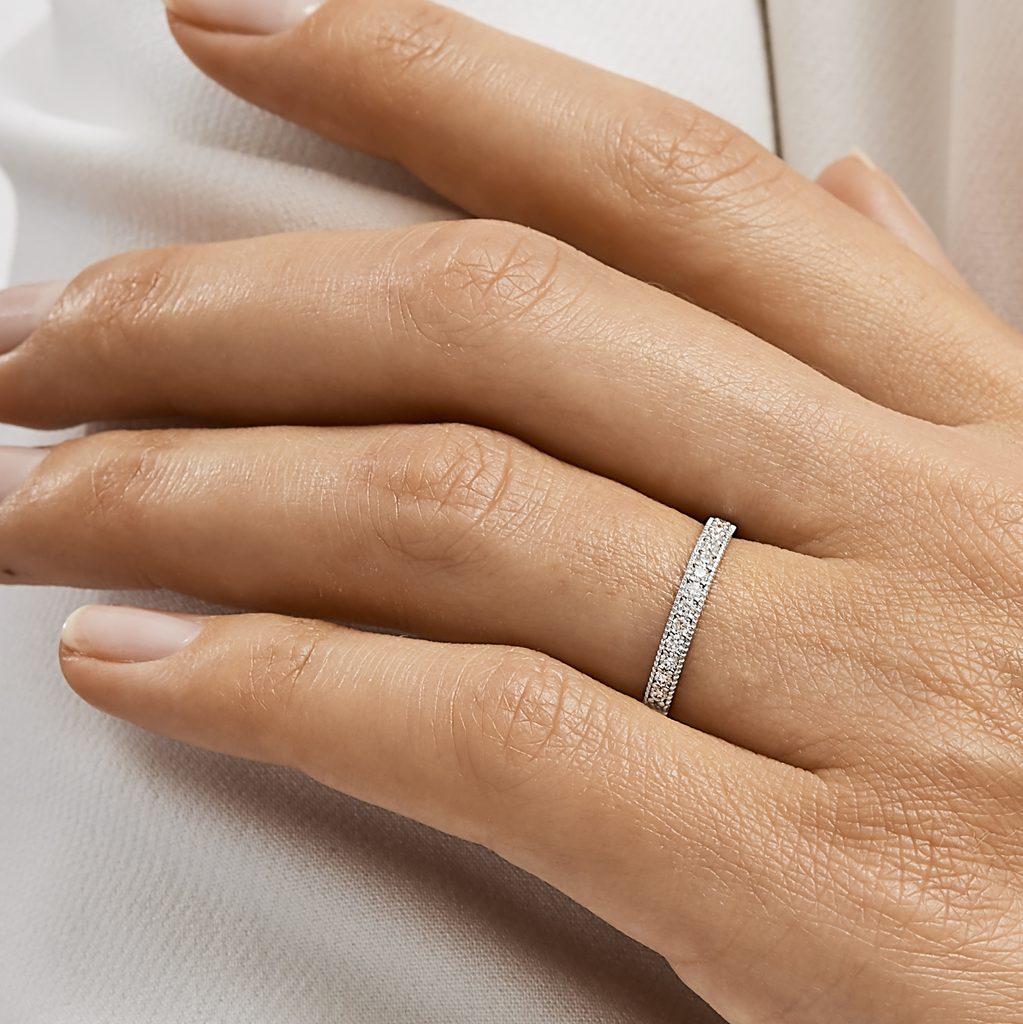
What Is a White Gold Ring?
A white gold ring is a piece of jewelry crafted from “white gold”—an alloy of pure gold mixed with white metals to create a silvery appearance—often finished with a rhodium plating to enhance its shine and durability. Pure gold (24k) is naturally yellow, so white gold is created by combining gold with metals like nickel, palladium, or silver, which counteract the yellow hue. White gold rings are available in various purity levels (measured in karats) and designs, from simple bands to elaborate styles with gemstones like diamonds or birthstones.
Key Characteristics of White Gold Rings
-
Gold Purity (Karats): The “karat” (k) rating indicates the amount of pure gold in the alloy, with common options for white gold rings including:
-
10k White Gold: 41.7% pure gold mixed with 58.3% white metals (often nickel and copper). It’s the most durable and affordable option, with a slightly warmer (less bright) white tone.
-
14k White Gold: 58.3% pure gold mixed with white metals (palladium or nickel). The most popular choice—it balances durability, shine, and value, with a bright white finish that pairs beautifully with gemstones.
-
18k White Gold: 75% pure gold mixed with high-quality white metals (usually palladium). It has a richer, more luxurious feel but is softer (prone to scratches), making it better for occasional wear or delicate designs.
-
Rhodium Plating: Almost all white gold rings are coated with rhodium—a rare, silvery-white metal—to:
-
Enhance shine: Rhodium gives white gold a mirror-like finish that rivals platinum.
-
Prevent tarnish: It protects the underlying alloy from discoloration caused by skin oils or chemicals.
-
Hide warmth: For lower-karat white gold (10k), rhodium covers any subtle yellow undertones, ensuring a consistent white appearance.
-
Gemstone Compatibility: White gold’s neutral tone makes it the perfect setting for gemstones:
-
Diamonds: White gold enhances a diamond’s sparkle by reflecting light back through the stone—this is why it’s a top choice for engagement rings.
-
Colored Gemstones: It complements both light gemstones (e.g., sapphires, aquamarines) and dark gemstones (e.g., onyx, emeralds), making the colors pop without clashing.
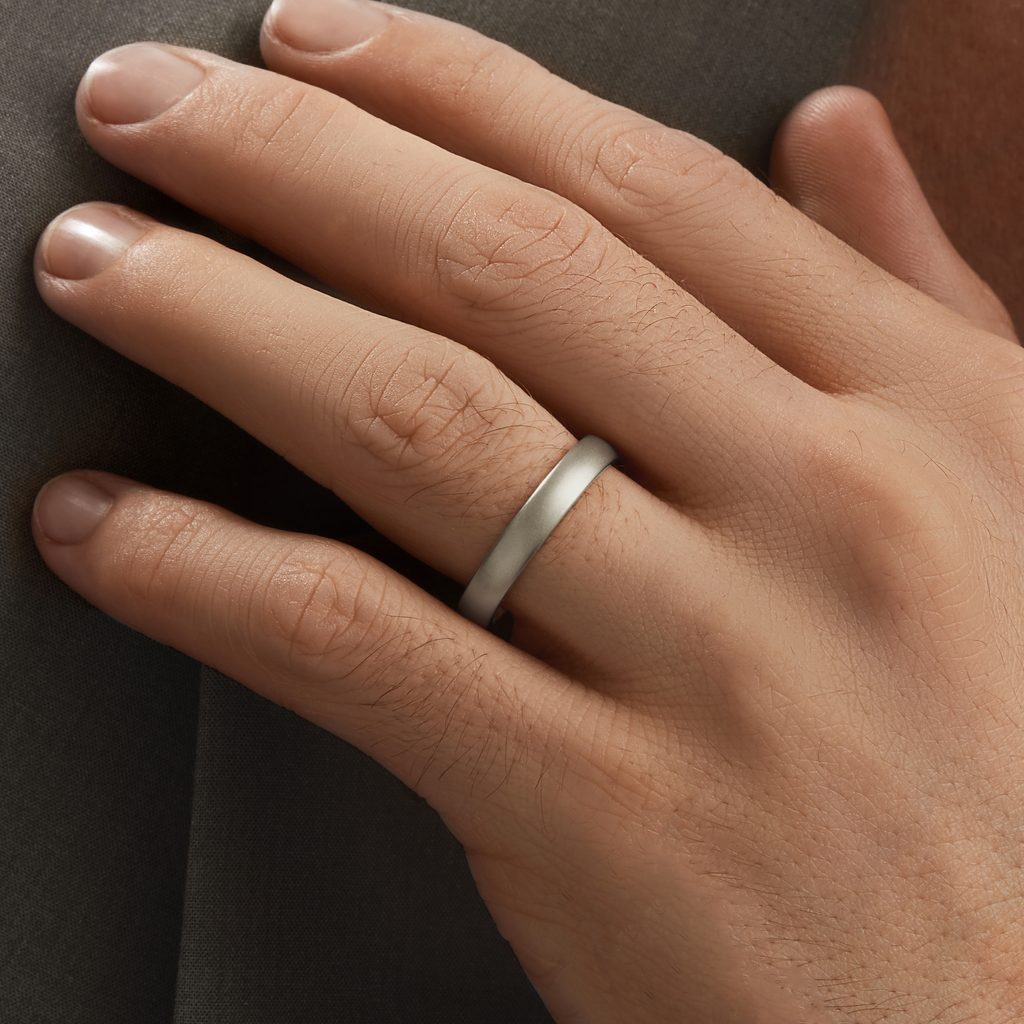
How White Gold Rings Differ from Similar Metals
-
vs. Yellow Gold Rings: White gold has a cool, silvery finish, while yellow gold is warm and traditional. White gold pairs better with silver-toned jewelry (e.g., stainless steel watches) and cooler clothing colors (blues, grays), while yellow gold complements warm tones (oranges, browns).
-
vs. Platinum Rings: Platinum is a pure white metal (no alloy needed) that’s denser and more durable than white gold—but it’s 2–3 times more expensive. White gold offers a similar look at a fraction of the cost, though it requires occasional rhodium re-plating (platinum does not).
-
vs. Silver Rings: Sterling silver is more affordable than white gold but is softer (prone to bending) and tarnishes easily. White gold is more durable, resistant to tarnish (thanks to rhodium), and retains its value better over time.
Why Is a White Gold Ring So Popular?
White gold rings have remained a top choice for decades because they address key consumer needs: versatility, affordability, and style. Their popularity spans demographics, from young professionals to married couples, and they’re a favorite for both everyday wear and milestone moments. Below are the key reasons for their enduring appeal:
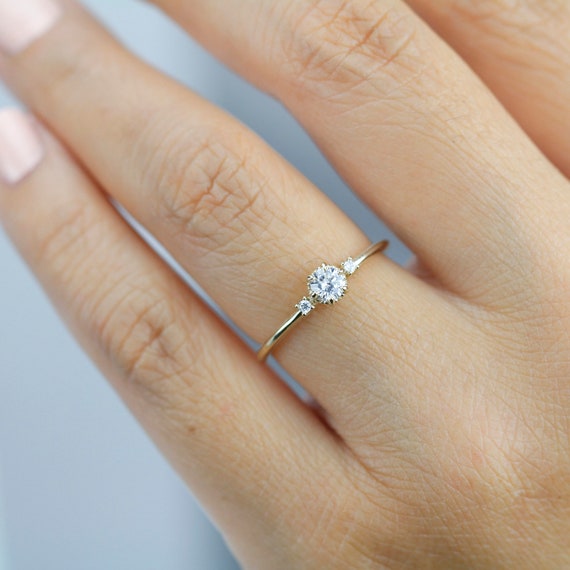
Versatility for Every Outfit & Occasion
White gold’s neutral tone makes it the most versatile metal for jewelry:
-
Everyday Wear: A simple 14k white gold band pairs with jeans and a t-shirt, a work uniform, or loungewear—no need to switch it out for different looks.
-
Formal Events: An elaborate white gold ring with diamonds complements a gown, tuxedo, or cocktail dress—adding sophistication without feeling over-the-top.
-
Stacking: Thin white gold bands can be stacked with other rings (yellow gold, rose gold, or gemstone styles) to create a personalized, on-trend look.
Affordable Alternative to Platinum
Platinum is often seen as the “luxury” white metal, but its price (often \(800–\)2,000 for a simple band) is out of reach for many shoppers. White gold offers a nearly identical appearance at a much lower cost: a 14k white gold band costs \(150–\)400, making it accessible for budgets large and small. This affordability doesn’t mean sacrificing quality—14k white gold is durable enough to last for decades with proper care.
Complements All Skin Tones
Unlike yellow gold (which can wash out cooler skin tones) or rose gold (which may clash with warm skin tones), white gold flatters every complexion:
-
Cool Skin Tones (pink/blue undertones): White gold enhances the natural brightness of cool skin, creating a cohesive look.
-
Warm Skin Tones (yellow/peach undertones): The contrast between white gold and warm skin adds depth, making the ring stand out without looking harsh.
-
Neutral Skin Tones: White gold complements both warm and cool colors, making it a no-fuss choice for those with balanced undertones.
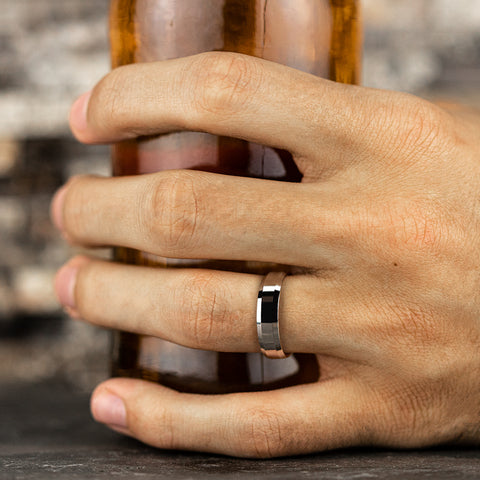
Timeless Style That Never Goes Out of Trend
White gold has been popular for over a century, and its appeal shows no signs of fading. Unlike trendy metals (e.g., black-plated silver) that come and go, white gold’s sleek, classic look remains relevant year after year. It’s a staple in engagement rings, wedding bands, and everyday jewelry—proving that it’s not just a trend, but a timeless investment.
Popular Styles of White Gold Ring
White gold rings come in endless designs, from minimalist to elaborate, ensuring there’s a style for every taste and purpose. Below are the most in-demand options:
Solitaire White Gold Ring (Engagement & Milestones)
A solitaire ring features a single gemstone (usually a diamond) set in a simple white gold band—timeless and elegant, perfect for engagement rings or anniversary gifts:
-
Diamond Solitaire: A round, princess, or pear-cut diamond (0.50–2.00 carats) in a four-prong or bezel setting on a 14k white gold band. The four-prong setting maximizes sparkle, while the bezel setting offers extra protection for the gemstone.
-
Birthstone Solitaire: A colored gemstone (e.g., sapphire for September, ruby for July) in a white gold setting—ideal for those who want a unique twist on the classic solitaire.
Stackable White Gold Band (Everyday & Layering)
Stackable bands are thin, simple white gold rings designed to be worn alone or with other rings—great for building a personalized stack:
-
Plain Stackable Band: A 1–2mm thick 14k white gold band with a polished or matte finish. It’s lightweight enough for daily wear and pairs with any other ring style.
-
Pavé Stackable Band: A thin white gold band with tiny diamond or cubic zirconia accents (0.01–0.05 carats each) set closely together. The subtle sparkle adds glamour without being overwhelming.
-
Engraved Stackable Band: A white gold band with a small engraving (e.g., a date, initial, or symbol like a heart or infinity sign). It’s a sentimental choice for everyday wear or gifting.
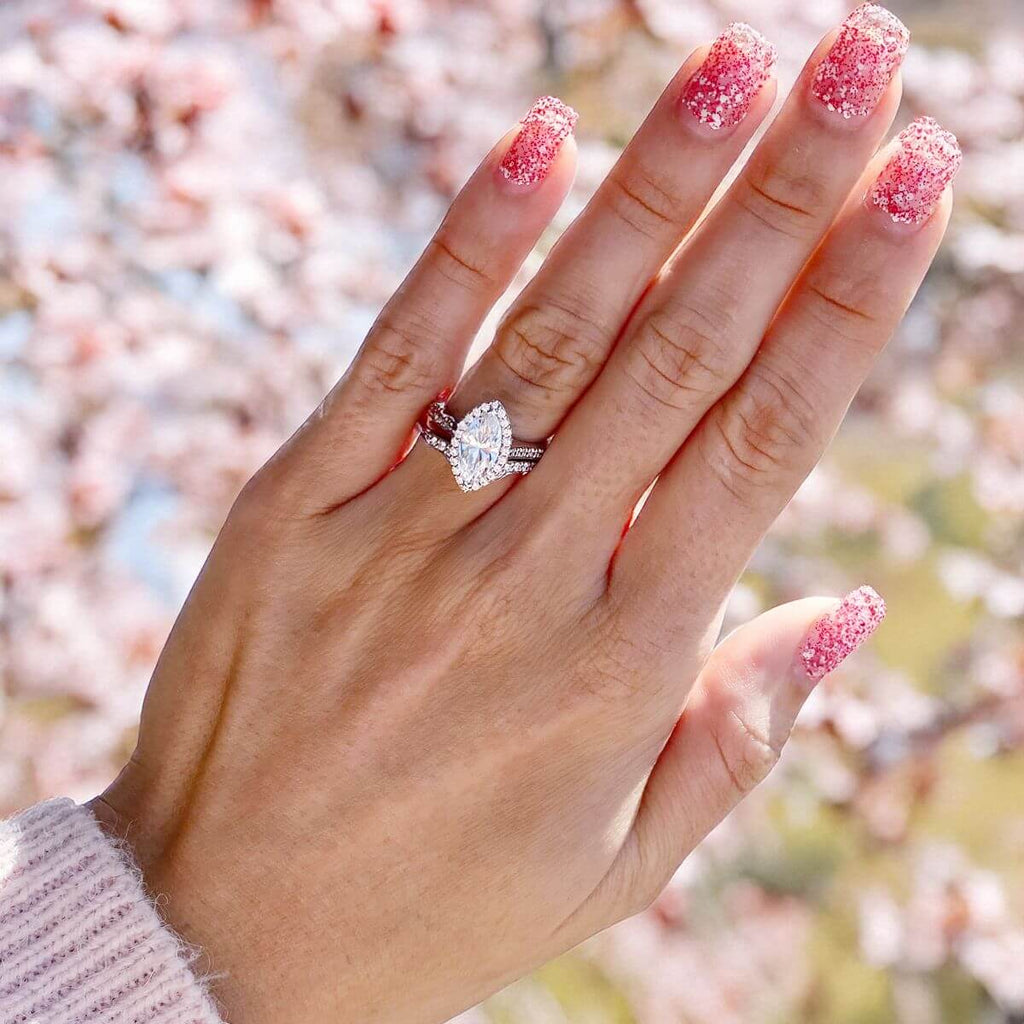
Halo White Gold Ring (Formal & Sparkly)
A halo ring features a central gemstone surrounded by a “halo” of smaller gemstones—creating the illusion of a larger stone and adding extra sparkle:
-
Diamond Halo Ring: A round diamond (0.75–1.50 carats) surrounded by tiny pavé diamonds on a 14k or 18k white gold band. It’s a popular choice for engagement rings or anniversary gifts, as it feels luxurious and eye-catching.
-
Colored Gemstone Halo Ring: A central sapphire or emerald surrounded by a halo of diamonds—perfect for those who want a pop of color with their sparkle.
Vintage-Inspired White Gold Ring (Classic & Unique)
Vintage-style white gold rings draw inspiration from eras like the Art Deco (1920s) or Victorian (1830s–1900s) periods, featuring intricate details and old-world charm:
-
Art Deco White Gold Ring: A geometric design with clean lines, filigree work, and gemstones like baguette-cut diamonds or sapphires. It’s a bold choice for formal events or anyone who loves retro style.
-
Victorian White Gold Ring: A delicate ring with engraved patterns, pearl accents, and a small central gemstone. It’s a romantic option for those who prefer subtlety and history.
How to Wear a White Gold Ring
Wearing a white gold ring is easy—its versatility lets you style it for any look, whether you’re going casual, professional, or formal. Below are tips to make the most of its sleek appeal:
Styling for Casual Looks
-
Solo Stackable Band: Wear a thin 14k white gold stackable band on your index or middle finger with a t-shirt, jeans, and sneakers. Keep other jewelry minimal (e.g., small silver stud earrings) to let the ring shine.
-
Layered Stack: Mix 2–3 white gold rings (a plain band, a pavé band, and a solitaire band) on the same finger. Pair with a denim jacket or oversized sweater for a trendy, effortless vibe.
-
Casual Loungewear: Add a simple white gold band to an oversized hoodie and leggings. Throw on ankle boots or fuzzy slippers for “elevated loungewear” that’s perfect for coffee runs or hanging with friends.
Styling for Work Wear
-
Minimalist Solitaire Ring: A small white gold solitaire ring (0.30–0.50 carat diamond or birthstone) pairs with a blazer, button-down shirt, and tailored trousers. It’s subtle enough for meetings but adds a touch of sophistication to a plain outfit.
-
Single Stackable Band: A thin white gold band on your ring finger works with a knit sweater, wide-leg pants, and loafers. It’s professional without being distracting—ideal for a corporate or creative office.
-
Match to Accessories: If you wear a silver watch or white gold jewelry (e.g., a necklace), your white gold ring will complement them seamlessly. Avoid mixing with too many yellow or rose gold pieces, which can create a cluttered look.
Styling for Formal Occasions
-
Halo White Gold Ring + Gown: A diamond halo white gold ring pairs beautifully with a floor-length gown in a neutral color (black, champagne, or ivory). Add a white gold necklace or earrings to complete the look—keep the focus on the ring’s sparkle.
-
Vintage-Inspired Ring + Cocktail Dress: An Art Deco white gold ring with sapphire accents complements a knee-length cocktail dress and strappy heels. Add a small clutch with silver hardware to match the ring’s tone.
-
Statement Ring + Evening Outfit: For a bold look, wear a large white gold ring with a silk camisole and tailored trousers. Skip other finger jewelry—let the statement ring be the focal point of your outfit.
White Gold Ring: Perfect Gift for Your Wife
A white gold ring is one of the most thoughtful gifts you can give your wife—it’s personal, timeless, and shows you’ve paid attention to her style and preferences. Whether you’re celebrating an anniversary, her birthday, or just want to say “I love you,” a white gold ring is a gift she’ll wear and cherish for years.
Why It Resonates as a Wife Gift
-
Sentimentality: Unlike generic gifts (e.g., flowers, perfume), a white gold ring carries emotional weight. It can symbolize your love, a shared milestone (e.g., your wedding anniversary), or a personal detail (e.g., her birthstone).
-
Everyday Wear: She’ll wear it nearly every day—whether to work, running errands, or date nights—so every time she looks at it, she’ll think of you.
-
Versatility: It fits her style, no matter what she prefers—minimalist if she likes subtlety, halo if she loves sparkle, or vintage if she adores retro designs.
Top White Gold Ring Gifts for Your Wife
-
14k White Gold Pavé Stackable Band: A thin band with tiny diamond accents—perfect for adding to her existing ring stack or wearing alone. It’s versatile enough for everyday wear and pairs with any outfit.
-
14k White Gold Birthstone Solitaire Ring: A small solitaire ring featuring her birthstone (or your children’s birthstones) in a simple setting. It’s a sentimental choice that honors her identity or family.
-
18k White Gold Diamond Halo Ring: A luxury gift for milestones like a 10th or 25th anniversary. The halo design adds sparkle, and the 18k gold feels indulgent—showing her how much she means to you.
Tips for Choosing the Right One
-
Know Her Style: If she wears delicate jewelry, opt for a thin stackable band or small solitaire. If she loves bold pieces, go for a halo or vintage-inspired ring.
-
Check Her Ring Size: Borrow one of her existing rings to measure (or ask her jeweler for help). If you’re surprising her, choose an adjustable band or a style that can be resized easily.
-
Add a Personal Touch: Engrave the inside of the band with a meaningful date (your wedding day, the day you met) or a short message (e.g., “My Forever”). It’s a small detail that makes the gift feel uniquely hers.
How to Clean a White Gold Ring
White gold rings require regular cleaning to maintain their shine and protect the rhodium plating. The process is simple and can be done at home with common household items—just avoid harsh chemicals that can damage the plating.
Daily Care to Prevent Dulling
-
Wipe After Wear: Use a soft, dry microfiber cloth to wipe the ring after each wear. This removes skin oils, lotion, or makeup that can build up on the surface and dull the rhodium finish.
-
Remove Before Activities: Take off the ring before showering, swimming, cooking (grease can tarnish metal), or applying hairspray/perfume (chemicals can damage rhodium).
-
Store Properly: Keep the ring in a soft jewelry pouch or a jewelry box with a padded compartment. Avoid storing it with other rings that have sharp edges (they can scratch the rhodium plating).
Step-by-Step Cleaning Process
-
Mix a Mild Solution: In a small bowl, combine 1 cup warm water with 1 drop of mild dish soap (like Dawn—avoid bleach, ammonia, or antibacterial soap, which can strip rhodium).
-
Soak the Ring: Let the ring soak for 10–15 minutes. This loosens dirt from the band and any gemstone settings (e.g., prongs or pavé accents).
-
Scrub Gently: Use a soft-bristled toothbrush (or a cotton swab for delicate gemstones) to scrub the ring—focus on the inside of the band (where dirt builds up) and around gemstone settings. Be gentle—too much pressure can scratch rhodium or loosen prongs.
-
Rinse and Dry: Rinse the ring under warm water to remove soap residue, then pat it dry immediately with a microfiber cloth. Buff the surface gently to restore its shine.
When to Re-Plate with Rhodium
Over time (6–12 months for daily wear), the rhodium plating on white gold rings will wear off, revealing the underlying alloy’s slightly yellow tone. Signs it’s time to re-plate include:
-
A dull, yellowish appearance.
-
Visible scratches or wear on the band.
You can have the ring re-plated at a local jeweler for \(50–\)100—this simple process restores its bright white finish and extends its lifespan.
How Do You Make a White Gold Ring?
Creating a white gold ring is a multi-step process that combines metallurgy, design, and craftsmanship. Below is a breakdown of the key steps, from alloy creation to the final rhodium plating:
Step 1: Create the White Gold Alloy
-
Mix Pure Gold with White Metals: To make white gold, jewelers melt pure gold (24k) with white metals—common combinations include:
-
14k White Gold: 58.3% pure gold + 41.7% palladium (for high-quality) or nickel (for more affordable options).
-
18k White Gold: 75% pure gold + 25% palladium (nickel is rarely used here, as higher-karat gold requires more premium alloys to maintain a bright white tone).
-
Melting & Mixing: The metals are heated to 1,064°C (the melting point of gold) in a crucible, then stirred thoroughly to ensure a uniform alloy. Once mixed, the molten metal is poured into molds to create “ingots” (solid bars) that will be shaped into ring blanks.
Step 2: Shape the Ring Blank
-
Rolling the Ingot: The gold ingot is passed through a rolling mill to flatten it into a thin, uniform sheet or wire—depending on whether the ring is a solid band or has intricate details.
-
Forming the Band: For a simple band, the gold wire or sheet is bent into a circular shape using a mandrel (a cylindrical tool) and soldered at the seam to create a closed ring. The band is then filed down to smooth the edges and ensure a consistent thickness.
-
Adding Details: For more complex designs (e.g., pavé settings, engravings), jewelers use tools like drills, saws, or laser cutters to create grooves for gemstones or etch patterns into the metal.
Step 3: Set Gemstones (If Applicable)
-
Preparing Settings: For rings with gemstones, jewelers carve or stamp “settings” (prongs, bezels, or pavé holes) into the band. Prong settings are bent into shape to hold the gemstone securely, while bezel settings are created by wrapping a thin strip of gold around the gemstone’s edge.
-
Setting the Stones: The gemstone (e.g., diamond, birthstone) is placed into the setting, and the prongs are bent over the stone’s edge to hold it in place. For pavé settings, tiny gemstones are placed into pre-drilled holes and secured with small amounts of metal pushed over the edges (called “beading”).
Step 4: Polish & Finish the Ring
-
Buffing: The ring is polished using a series of rotating brushes and compounds (from coarse to fine) to remove scratches and create a smooth surface. This step brings out the metal’s natural shine.
-
Rhodi Plating: The final (and critical) step for white gold rings is rhodium plating. The ring is dipped into a rhodium solution and subjected to an electric current (electroplating), which deposits a thin layer of rhodium (0.1–0.5 microns thick) onto the surface. This gives the ring its bright white finish and protects the underlying alloy.
-
Quality Check: The ring is inspected for defects (e.g., loose gemstones, uneven plating) and cleaned one last time to remove any residue.
Step 5: Engraving (Optional)
If the ring is personalized (e.g., a wedding band with a date), jewelers use a laser or hand-held tool to engrave the desired text or design onto the inside or outside of the band. The engraving is then polished to ensure it’s legible and smooth.
How Much Is a 14k White Gold Ring Worth?
The value of a 14k white gold ring depends on two main factors: the weight of the gold (intrinsic value) and additional features (gemstones, craftsmanship, brand). Below is a breakdown of how to calculate its worth, plus typical price ranges for different styles:
Intrinsic Value: Value of the Gold Itself
The intrinsic value is the market value of the pure gold in the ring, calculated using:
-
Gold Weight: First, weigh the ring in grams (most 14k white gold bands weigh 2–5 grams).
-
Pure Gold Content: 14k gold is 58.3% pure gold, so multiply the ring’s weight by 0.583 to get the weight of pure gold. For example, a 3-gram 14k ring contains 3 × 0.583 = 1.749 grams of pure gold.
-
Current Gold Price: Check the daily spot price of gold (e.g., \(60 per gram as of 2024). Multiply the pure gold weight by the spot price: 1.749 grams × \)60 = $104.94.
This means the intrinsic value of a 3-gram 14k white gold ring is ~$105. Note: This does not include the value of gemstones, craftsmanship, or brand.
Total Value: Adding Gemstones & Craftsmanship
The total retail value of a 14k white gold ring includes the intrinsic value plus costs for gemstones, design, and labor:
-
Plain 14k White Gold Band (No Gemstones): A simple 2–3 gram band costs \(150–\)400. The higher end includes polished finishes or subtle engravings.
-
14k White Gold Ring with Small Gemstones: A ring with 1–2 small diamonds (0.05–0.10 carats total) or a birthstone costs \(300–\)800. The price depends on gemstone quality (e.g., diamond clarity, birthstone type).
-
14k White Gold Ring with Large Gemstones: An engagement-style ring with a 0.50–1.00 carat diamond or colored gemstone costs \(800–\)3,000+. The price rises with gemstone size, cut, and quality (e.g., a 1.00 carat VS1 diamond adds \(1,500–\)2,500 to the ring’s value).
-
Brand-Name 14k White Gold Rings: Luxury brands (e.g., Tiffany & Co., Cartier) charge a premium for design and brand recognition. A Tiffany 14k white gold solitaire ring with a 0.50 carat diamond costs \(3,000–\)5,000, compared to \(800–\)1,500 for a non-branded equivalent.
Resale Value of 14k White Gold Rings
If you sell a 14k white gold ring, you’ll typically get 50–70% of its intrinsic value (not retail value), as jewelers and pawn shops need to account for reprocessing costs. For example:
-
A 3-gram 14k white gold ring with no gemstones has an intrinsic value of ~\(105. Resale value: \)50–$75.
-
A 14k white gold ring with a 0.50 carat diamond has an intrinsic gold value of ~\(120 and a diamond resale value of \)300–\(500. Total resale value: \)350–$575.
Frequently Asked Questions About White Gold Rings
Q: Does 14k white gold turn yellow over time?
A: Yes—but only the rhodium plating wears off, revealing the underlying white gold alloy’s subtle yellow tone. The alloy itself does not “turn yellow”; it’s the protective rhodium layer that fades with daily wear (e.g., friction from clothes, contact with skin oils). This is easily fixed by re-plating the ring with rhodium (cost: \(50–\)100), which restores its bright white finish.
Q: Is 14k white gold hypoallergenic?
A: It depends on the alloy. Most 14k white gold is made with palladium (hypoallergenic) or nickel (which can cause irritation for sensitive skin). To avoid allergies:
-
Look for “nickel-free 14k white gold” (most high-end brands offer this).
-
Test the ring in-store: Wear it for 1–2 hours—if no redness or itching occurs, it’s safe.
-
Opt for palladium-based 14k white gold (more expensive but safer for sensitive skin).
Q: Can a white gold ring be resized?
A: Yes—most white gold rings can be resized by a jeweler, though the process depends on the design:
-
Plain Bands: Easy to resize—jewelers can add or remove a small section of the band (cost: \(30–\)80).
-
Rings with Gemstones: Resizing is trickier if gemstones are set near the band’s edge (e.g., pavé rings). Jewelers may need to temporarily remove gemstones to avoid damage, increasing the cost to \(80–\)150.
-
Engraved Rings: Resizing may distort engravings near the band’s seam—opt for engravings on the inside (not outside) if you think you’ll need resizing later.
Q: Is white gold better than platinum for an engagement ring?
A: It depends on your priorities:
-
Budget: White gold is 2–3 times cheaper than platinum—better for those on a budget.
-
Durability: Platinum is denser and more scratch-resistant than white gold—better for those with active lifestyles (no need for rhodium re-plating).
-
Appearance: Both have a bright white finish, but platinum develops a “patina” (soft, muted shine) over time, while white gold maintains a mirror-like finish with re-plating.
Q: How often should I clean my white gold ring?
A: Clean it weekly with mild soap and water to remove dirt and prevent buildup. For deep cleaning (e.g., after a vacation or heavy use), take it to a jeweler for professional cleaning (often free with purchase). Re-plate the ring every 6–12 months (or when you notice yellowing) to keep it looking its best.
Conclusion: White Gold Ring—Sleek Glam, Any Occasion
A white gold ring is more than just a piece of jewelry—it’s a versatile, timeless accessory that balances elegance, affordability, and sentiment. Whether you’re wearing it daily as a stackable band, celebrating an anniversary with a diamond solitaire, or gifting it to your wife as a symbol of love, it adapts to every moment with sleek glamour. From its alloy composition to its rhodium finish, every detail of a white gold ring is designed to last—making it a investment that will shine for years to come.
Now that you know how white gold rings are made, how to care for them, and their true value, it’s time to find your perfect piece. Browse our curated collection of white gold rings—from minimalist 14k bands to luxurious diamond halos—and use code WHITEGOLD20 to get 20% off your first order. Whether you’re treating yourself to everyday elegance or surprising your wife with a meaningful gift, a white gold ring is the perfect way to add sleek glamour to any occasion. Shop now and embrace the timeless shine of a white gold ring.


